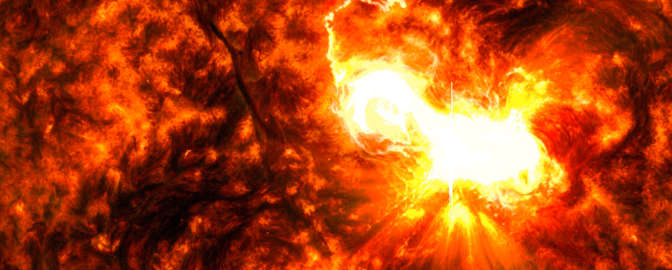What "phase angle" means

Written by
Emily Lakdawalla
October 27, 2009
I'm going to ask you to indulge me in a geek-fest today. As is probably obvious by now, I love playing with spacecraft image data. I am always looking for excuses to dive into space image archives to unearth images of stuff in space that haven't really been seen by very many people before.
The other day, while playing around with the latest update to the Cassini archives, I decided to see how the appearance of one of Saturn's moons changed with phase angle. "Phase angle" means the angle from the Sun, to the target being observed, to the observer -- it's basically a number applied to the descriptive terms we use for lunar phases like crescent, half, gibbous, and full. But apart from the fact that I know "full" is equivalent to zero phase, "half" is a phase of 90 degrees, and "new" is equivalent to 180 degrees, I realized I didn't have a good intuitive feel for what moons look like at different phase angles. So I thought I'd dig in to some data and make a montage of images at different phase.
I thought I'd start with one of the medium-sized icy moons, picking Rhea because it's relatively large (meaning that there should be lots of decent-resolution photos of it) and because its appearance is fairly constant over its globe -- it doesn't have Dione's "wispy terrain" or Tethys' enormous chasm. So geographic features won't distract from what I'm trying to look at, which is how the moon's appearance changes with changing phase. I tried to pull out one image of Rhea at every increment of 10 degrees of phase. Of course, Cassini hasn't seen it at every possible phase angle, so I didn't quite get to perfect multiples of 10 in all cases, but I got pretty close:

These images are calibrated, so they correctly show how Rhea's brightness varies with phase -- up to a point (more on that in a moment). It should be no surprise that Rhea appears brightest at zero phase, and gets darker as you get to a smaller and smaller crescent. It's really really dark at a phase of 138 degrees; I did find one other image at higher phase, but the crescent was basically invisible so I decided not to include it.
But Rhea isn't completely featureless across its surface. In fact, like all of Saturn's icy moons, there is a strong relationship between longitude and surface brightness: its leading hemisphere is brighter -- and bluer -- than its trailing hemisphere; there are nice maps of this on Paul Schenk's blog. According to Anne Verbiscer, Rhea is roughly a quarter of a magnitude brighter on its leading hemisphere than its trailing hemisphere (this behavior does vary with wavelength). Since I completely ignored the effects of latitude and longitude here -- some of the images look at leading hemisphere, some at trailing hemisphere, some up from the south and some down from the north -- there are some images in the sequence that look brighter or darker than they would if I had been able to hold latitude and longitude constant.
Cassini has returned well over 200,000 images from the Saturn system, but it hasn't surveyed every moon at every latitude and longitude at every possible phase angle; we do the best we can with what we have, and always hope to get more data. If you've ever wondered what the point is in Cassini getting more and more images of the moons, this is why -- Cassini will never fully sample every possible combination of latitude, longitude, and phase; more images will fill in gaps and make a more complete picture of the moon's photometric behavior, which tells us what its surface is made of and how it varies from place to place.
That was an interesting exercise; doing it for Tethys or Dione or Mimas probably wouldn't produce any further surprises. But what about Titan, the moon with an atmosphere? How its appearance varies with phase angle is quite different. Here's the equivalent montage for Titan:

The most obvious difference between Titan and Rhea is what happens at high phase angles. You're marching along from left to right, seeing Titan go from a fuzzy full to gibbous to half to crescent phases, but then what's happening at phases higher than 150 degrees? We're seeing Titan's atmosphere, surrounding the moon, backlit by the Sun. Just like Saturn's F and E rings, Titan's atmosphere is full of very tiny particles that "forward scatter" light, meaning that it appears brightest at the highest phase angles. You can even see the Sun lighting up the atmosphere on what should be a nighttime side of the moon. Titan's surface is dark because the atmosphere absorbs, scatters, and reflects much of the sunlight that impinges on it, but some of that scattered sunlight scatters around into the nighttime sky, giving places on Titan's surface a very long period of twilight at each Titanian dawn and dusk.
Another thing that Anne pointed out to me is that, unlike Rhea, at phases under 90 degrees, Titan's brightness does not vary at all with phase. Rhea's varying brightness with phase is largely a product of shadowing -- when we look at Rhea at higher phase angles, we see a lot of shadowed sides of topographic features. Titan's atmosphere is incapable of this sort of self-shadowing, so its brightness doesn't vary with phase until you get to high phase angles, where the forward scattering kicks in.
You might wonder why the Titan images start at 12 degrees phase instead of zero. The answer is that Cassini hasn't yet seen Titan at near-zero phase. (Actually, Jason Perry tells me it did see Titan at near-zero phase last month, but those images aren't in the public archive yet.) My hunch is that this isn't because the team didn't care about seeing Titan at zero phase; rather, it's because of orbital mechanics. Titan is the only moon that Cassini can use for gravity-assist adjustments of its trajectory. Therefore, the geometric circumstances under which it approaches Titan are constrained by the shape of Cassini's orbit. It just hasn't happened very often that the encounter geometry that is required for Cassini's orbital adjustments have allowed Cassini to look at Titan at lower phases. The other moons orbit independently of Cassini's path, so chance distant observing opportunities have generated pretty full phase coverage of the other moons. Anne told me that there wouldn't be a whole lot to learn about Titan's atmosphere from zero phase that adds to what we've learned from observations at other angles, but the surface is a different matter; she said that "low phase VIMS observations would reveal quite a lot about the surface."
P.S. you should thank me for refraining from titling this blog entry something horrible like "it's only a phase..."
Earth's First Line of Defense
Support the team of astronomers defending Earth with a gift today.
Donate

 Explore Worlds
Explore Worlds Find Life
Find Life Defend Earth
Defend Earth

